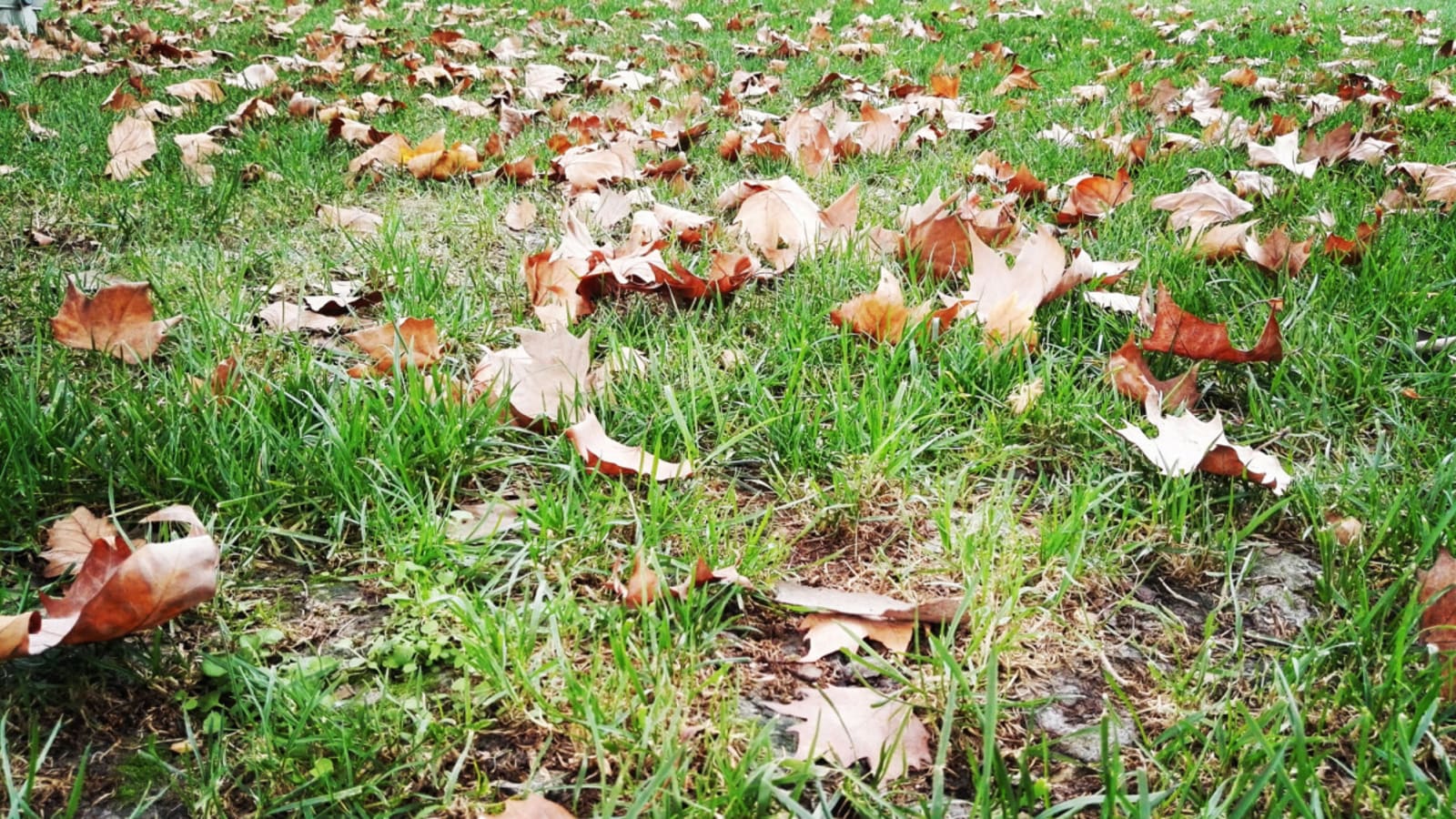
Laying new grass seed in the fall is one of the best ways to achieve a thick, green lawn, and come spring, you'll be glad you did it. Cooler temperatures, increased rainfall, and less competition from weeds create ideal conditions for grass seed to take root and thrive. If you’re looking to up your lawn game, here’s how to get it right without overcomplicating things.
Why Fall is the Best Time to Seed Your Lawn
Simply put, it's easier. The soil is still warm from summer, but the air is cooler, resulting in the perfect conditions for seed germination. Many geographies also incur a more consistent rainfall, meaning less time lugging around hoses or sprinklers. And with fewer weeds sprouting up, your grass seed has a better shot at establishing itself without too much competition.
Does the pH of your soil matter?
"Soil pH affects everything from nutrient availability to root development, which can have an impact on how well grass will establish and grow," shares Matthew Koch, Ph.D., Director of Biotechnology, Genetics, and Seed at Scotts. "The absorption of key nutrients like nitrogen, phosphorus, and potassium, which are essential for healthy grass seed growth, can be impacted by soil pH. A pH range of 6.0 to 7.0 is typically ideal for most grasses. If the pH is too acidic (below 6.0) or too alkaline (above 7.5), nutrient uptake is limited, causing grass to struggle in its early stages of growth."
He adds, "In addition to nutrient availability, proper pH levels support the activity of soil microorganisms that break down organic matter, releasing even more nutrients that new grass seedlings rely on. If the pH is imbalanced, microbial activity slows down, reducing the overall nutrient supply. Moreover, balanced pH encourages strong root development, allowing grass to grow deeper roots and better withstand environmental stress."
How to Prepare Your Lawn for a Fall Seeding
A little prep work goes a long way in setting the stage for a lush lawn. Here’s how to get your lawn ready:
- Test Your Soil: A quick soil test (you can find simple kits at most garden stores) can tell you if your soil pH needs adjusting. "When the pH is in the optimal range of 6.0 to 7.0, grass seedlings build a resilient structure, making them more resistant to diseases and better equipped to handle harsh conditions like drought or pests," notes Koch. "Testing and adjusting soil pH before planting ensures that your lawn gets the nutrients it needs, leading to healthier, stronger grass in the long term." If your pH is off, adding lime or sulfur can help balance it out.
- Clear the Area: This is the perfect time to mow the lawn short and remove any debris like sticks, leaves, or rocks. You want as much seed-to-soil contact as possible for the best results.
- Aerate (If Needed): This step helps if your soil is compacted or you haven’t aerated in a while. Aerating pokes holes in your lawn, allowing air, water, and nutrients to reach the roots.
-
Tackle Weeds: If weeds are an issue, clear them out. Use a non-selective herbicide if necessary, but make sure to wait the recommended time before seeding.
Choosing the Right Grass Types
Not all grass seeds are created equal, and picking the right type is important for success. Fall is best for cool-season grasses like Kentucky bluegrass, fescue mix, and ryegrass, as all thrive in cooler temperatures. For those in transitional zones, a blend that includes both cool and warm-season grass varieties can offer the best of both worlds.
Remember to check the product label. Look for seed mixes with a high germination rate and little to no filler. Avoid seed products with a lot of weed seed or “coated” seed if you’re on a budget; you’re paying for less seed and more coating.
How to Plant Grass Seed the Right Way
Now that your lawn is prepped and you’ve got the right seed, it’s time to get planting.
- Spread Evenly: The best time of day to plant is early morning or late afternoon when the sun isn’t too harsh. This prevents the seeds from drying out too quickly. Use a broadcast spreader for larger areas, or a handheld rotary spreader for smaller spots. Spread the seed evenly, aiming for full coverage without overdoing it—too much seed can lead to overcrowding and weaker grass.
- Rake and Roll: Lightly rake the area to mix the seed with the top layer of soil. Then, use a lawn roller or simply walk over the area to press the seed into the soil. This step helps ensure good seed-to-soil contact, which is key for germination.
- Water Wisely: Water lightly but consistently. You want the top inch of soil to stay moist but not soaked. Typically, this means watering once or twice a day until the seeds sprout, then gradually reducing as the grass establishes.
- Cover with a Thin Layer: For better protection and moisture retention, consider lightly covering the seed with straw or a thin layer of compost. This step helps keep birds away and prevents the seed from washing away in heavy rain.
- Feed the new grass: "Two fall feedings are recommended," notes Koch. "An early fall application of fertilizer helps repair grassroots damaged by summer heat. If weeds are an issue, use Scotts® Turf Builder® WinterGuard® Fall Weed & Feed3 to tackle both fertilization and weed control. Then, after 6-8 weeks, apply Scotts® Turf Builder® WinterGuard® Fall Lawn Food to nourish your lawn and help it store energy for spring growth."
Does the feeding schedule vary based on where I’m located?
Yes, in fact it does. “In cool-season climates where cool-season grasses are best suited, like the Northern U.S., Midwest and Northeast, early fall feeding typically starts in September or early October when temperatures cool down but before the first frost,” shares Koch. “The second feeding is recommended 6-8 weeks later, which often falls in late October or November. This helps the lawn recover from summer stress and store energy for winter and early spring growth.”
He adds, “For warm-season grasses in the Southern U.S. or Southeast, the feeding schedule may begin earlier in late August or early September, as these regions experience milder winters and longer growing seasons. Timing the first application before the lawn enters dormancy is crucial, and the second feeding would occur 6-8 weeks later, likely in October.”
“Additionally, in areas with high altitudes, colder temperatures can set in earlier, so fall feeding may need to happen sooner—late August to early September for the first feeding and mid-October for the second. Fertilizing too late may be ineffective if the ground freezes early. In desert areas with extreme summer heat like the Southwest, the first fall feeding may start in early September, but watering practices are also critical to avoid lawn stress. The second feeding should happen before temperatures drop significantly, usually by early November.”
Should I aerate my soil first?
Yes, if possible. "Aeration helps break down thatch layers," explains Koch. "Thatch is a layer of dead grass, roots, and other organic material that can suffocate your lawn if it becomes too thick. Aeration makes it easier for your lawn to breathe and prevents potential issues like fungal growth."
Why is my grass seed not growing?
Unfortunately, there could be a number of reasons. When it comes to lawn seeding, the most common issues include poor seed-to-soil contact, uneven watering, and planting too deeply. Make sure your soil is well-prepped, and keep it consistently moist until the seeds germinate. If soil temperatures are still warm and you're still weeks out from a frost, you have plenty of time to correct issues and have a successful germination.
Can I just throw grass seed down?
While it’s tempting, scattering seed without prep work often leads to patchy growth and wasted seed. Prepping the soil surface in late summer helps ensure the seed has the best chance to take root. It also helps to prevent compacted soils.
How long does it take for grass seed to grow?
Most grass plants will start to sprout within 7 to 21 days, but it also depends on the type of seed, the soil, and the weather conditions. Patience is key—remember to keep the soil moist, and you’ll see results.
More must-reads:
- Yankees set a condition to re-sign Cody Bellinger
- Edwin Diaz has stinging words for Mets fans after Dodgers introduction
- The 'AL and NL MVPs since 2000' quiz
Breaking News
Trending News
Customize Your Newsletter
 +
+
Get the latest news and rumors, customized to your favorite sports and teams. Emailed daily. Always free!








